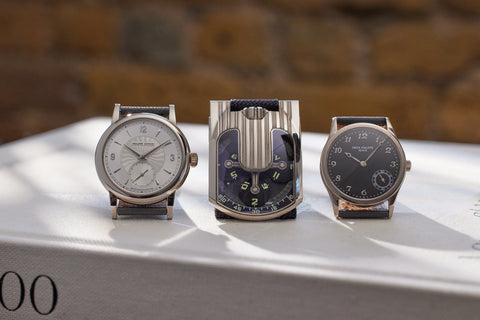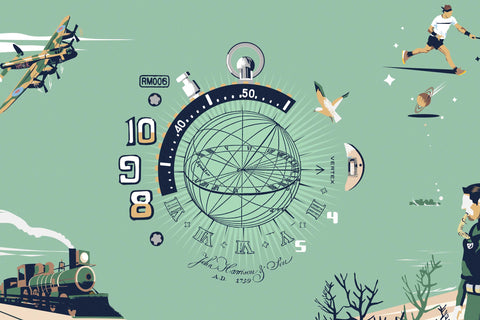
Inspirations Behind Today’s Independent Watchmakers
By Kwan Ann Tan
Inspiration is a difficult thing to pin down. Ancient poets and artists had their muses – living people that managed to inspire that spark of excitement that led to the creation of enduring art. For the earliest watchmakers, their work was borne out of scientific discovery and the need for accuracy in timekeeping. But these objects were not purely utilitarian; they were also a pleasure to look at, as evidenced by the intricate decoration that graces many of the watches.
In this piece, we explore the watchmakers that have inspired today’s independents, ranging from the historical figures that have influenced their work, mentors and teachers that encouraged them during their time at school, or contemporaries that they admire and respect. We spoke to seven independent watchmakers who shared stories about the heritage and history that they see their watchmaking as having descended from, and the people that have been important to their journeys today. Our hope is in doing so we gain further insight into what makes today’s independent creators so special.
Svend Andersen on Louis Cottier
“I am fortunate to have many influences. Most importantly, I always listen to the requests of collectors and customers. I learn from them as well as from reading many books and researching different styles and mechanisms. In my first four years as an independent watchmaker, I produced gold cases for old pocket-watch movements together with one of the industry’s last remaining casemakers who had the know-how. In this process, I learned about different styles and ‘époques’. Often the collectors and customers brought their own movements.


A Louis Cottier Patek Philippe World Time pocket watch and a Christophorus Columbus wristwatch with a module, courtesy of Phillips and Andersen Genève.
“By the mid 1980s, there was increased demand from Italian collectors for mechanical wristwatches. Again, I learned from them about style and design. I was fortunate to visit the Pininfarina studios on various occasions. Collectors asked me, ‘Can you make minute repeaters, calendars and automatons?’ And I did!.
“One of my main inspirations is the World Time display by Louis Cottier. When I worked at Patek Philippe, I had to assemble the last of the in-stock Cottier modules. I was extremely impressed by the ‘face’ of those watches because it allowed for all kinds of creative artworks and techniques.
“When I started making the World Time in 1989, I created a complete new module which included a mechanism of 0.9mm, including the dial. It was adaptable to different movements and indications leading to the creation of the Christophorus Columbus and 1884 timepieces. This technique is still being applied to the ANDERSEN Genève World Timers today, but with a slightly wider mechanism because of artwork applications such as enamel within the centre of the dial. The Mundus, the thinnest World Time watch at just 4.2mm, has the module inside the dial, which is only 0.5mm altogether.”

A selection of Louis Cottier Patek Philippe World Time watches and pocket watches, courtesy of Phillips.
Cyril Brivet-Naudot on Pierre Le Roy
“I have been influenced throughout my apprenticeship and my life as a watchmaker by illustrious predecessors. Among them, and like many watchmakers of my generation, is George Daniels, the last great watchmaker before the digital era that has so radically changed our profession. But the one who inspires me the most today and who undoubtedly made the most progress in watchmaking towards chronometry is Pierre Le Roy (1717-1785). His work is of great intelligence and simplicity.


A diagram of a Le Roy Marine Chronometer and Brivet-Naudot’s Eccentricity, which makes use of a free eccentric escapement, courtesy of Wikimedia Commons and Brivet-Naudot.
“Le Roy was daring in his choice to not put a fusée in his marine chronometers and in not caring about the direction of rotation of the hands if he could reduce the friction of a gear. He knew how to question the horological fundamentals of his time. Preferring the rigours of scientific experiments, meticulously and patiently conducted, to industrial espionage, and working to elevate his art to the rank of precision useful to society, he knew how to combine professional and human achievement.
“It is this brilliant mind, who at the end of his life was debating with the great scientists of the Enlightenment on the properties of light, that reminds me of how vain we all are to think that anything we create is a novelty today. I try to draw inspiration from his values every day to manufacture well-designed and sober watches, and I am working in parallel to publish his complete works so that his work becomes better known to watchmakers and watch lovers.”
Raúl Pagès on Albert Pellaton
“I would say that I have several watchmakers who have influenced me in different ways. Kari Voutilainen has been a major influence for me because at the time in my career when I started to dream of creating my own watches, Kari’s work started to have a huge recognition. He became my godfather when I applied to join the AHCI [Académie Horlogère des Créateurs Indépendants]. I admire his managing skills and independent spirit and I have always appreciated his classic and contemporary designs. It is also something that I am trying to do in my creations with my artistic sensibility.


The movement of the Albert Pellaton pocket watch Pagès worked on, courtesy of the Watchmaking Museum of Le Locle, Château des Monts, alongside the Raúl Pagès Régulateur à Détente RP1.
“From a technical point of view, I was lucky enough to restore many masterpieces. But it is a pocket watch by Albert Pellaton from the early 20th century that got me head over heels. This tourbillon with a detent escapement completely turned me upside down. The finishing of each component of this watch was breathtaking. The RP1 model I created is inspired by this technical watchmaking from the beginning of the 20th century.”
Sylvain Pinaud on Antide Janvier
“My watchmaking career has taken me from watchmaking school, where I worked alongside passionate teachers who shared their secrets, to watchmakers who restored clocks, opening my eyes to the long history of watchmaking. It was while working on two resonance clocks by Antide Janvier that I realised that beautiful watchmaking is the necessary marriage between science, know-how and beauty.


The Antide Janvier resonance clocks that Pinaud worked on – which now reside in the Patek Philippe Museum, courtesy of Antique Clocks Price Guide., and a prototype of Pinaud’s Origine, which won the Horological Revelation prize at the 2022 GPHG.
“I understood by studying the work of this master [Antide Janvier], born in the isolated mountains of the French Jura, that watchmaking was an infinite field of expression, combining artistic expression and mechanical refinement. What struck me in his work was the right proportion in each element, the harmonious and elegant forms. Which, in my opinion, makes them timeless objects.
“This man was totally committed to his work and mastered every aspect of it. This continually inspires me in my creations and pushes me to further expand my knowledge and skills.”
Daniel Roth on Abraham-Louis Breguet and George Daniels
“People who influenced the early days of my career include Breguet, who was an inspiration to me because of his style and his complicated watches. Back in those days, the best artisans of his time were working for him, and they contributed to his incredible oeuvre, which still impresses me today.

One of the earliest pieces created under Roth’s own name, the BB 2147, alongside a Breguet Classique Chronograph 3237, where Roth worked to translate the Breguet aesthetic into wristwatch form.
“I have also been inspired by George Daniels, who was influenced by Breguet as well. I really liked his handmade method of production, or ‘fait main’.
“However, nothing could replace or equal my learning process with the old watchmakers who trained me in my early days and transmitted their know-how and their taste for perfection.”
Kari Voutilainen on Abraham-Louis Breguet, Urban Jürgensen, and John Arnold
“I am impressed by the work of watchmakers from the 19th century, such as those of Abraham-Louis Breguet, Urban Jürgensen, and John Arnold, to name some of them.


An early Urban Jürgensen Reference 1 from the revival of the brand, under Peter Baumberger and Derek Pratt and helmed under Voutilainen, beside the movement of the Vingt-8, which pushes forward Breguet’s ‘natural escapement’ theory, and makes use of a Breguet overcoil.
“They invented and improved mechanisms, escapements and most importantly, the precision of these watches. They didn’t have the best metals or the materials we do today, but they had the know-how and skills to carry out their work, which we don’t have anymore. It is impressive to see watches made 200 years ago and how they are still in perfect shape.”
Bernhard Zwinz on Gerd-Rüdiger Lang
“It often happens that you meet people by chance who end up having a positive long-term effect on your life. Gerd-Rüdiger Lang of Chronoswiss was certainly one of those people; I accidentally met him at an exhibition in Schaffhausen where his watch brand was present.


An example of the Founder’s Series from Winnerl, and the Chronoswiss Chronoscope that Zwinz assembled with the movements produced by Andreas Strehler. Courtesy of Bonhams.
“Different from the well-known larger watch companies, Gerd’s brand was small and independent, and he was always very passionate about the history of mechanical watchmaking and his own vision of wristwatches. His way of working showed me that there were alternative ways to approach watchmaking which would prove useful for me many years later, when I would relaunch Winnerl. Chronoswiss was being sold at Preisig, the watch dealer where I was working as a watchmaker at the time, and inspired by Gerd’s passionate discussions, I became pretty adept at selling and promoting his timepieces to customers there – even to the wives of existing clients.
“A few years later Gerd contacted me to offer me a job at his company in Munich to take care of production and R&D. In this way I made several trips to Switzerland with him visiting suppliers, and I saw all the different makers of dials, hands, cases, and movements which was really instructive. Learning all the ins and outs of the production processes, [and] how pricing and delivery times work, was a very good learning experience for me, which stirred my thoughts at the time about creating my own timepieces.
“It was also at this time that I met my good friend Andreas Strehler, who was the constructor and producer of the Chronoswiss Chronoscope. I can still recall picking up the first prototype movements late at night from his workshop, driving directly back to Munich to further assemble the watch, and later the same day bringing the finished watches to the Inhorgenta Munich exhibition in 2001. It feels like yesterday in my mind; amazing to realise that this is now more than two decades ago.”
Our thanks to Svend Andersen, Cyril Brivet-Naudot, Raul Pages, Sylvain Pinaud, Daniel Roth, Kari Voutilainen, and Bernhard Zwinz for taking the time to share their inspirations with us.


















































































































































































